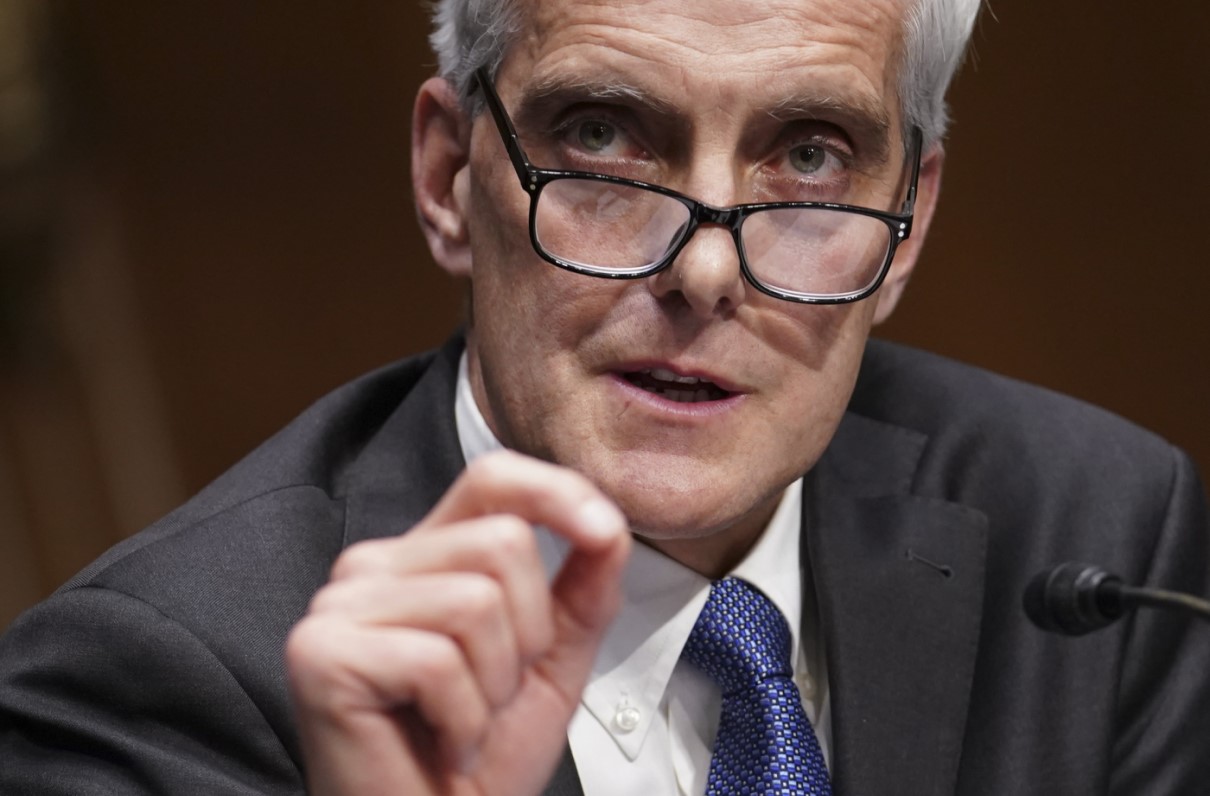The VA has finished its 12-week strategic review of the massive Cerner Millennium electronic health record modernization (EHRM) project, VA Secretary Denis McDonough announced June 30. Review completion came just in time for McDonough to answer concerned members of the Senate and House Committees on Veterans’ Affairs about VA Office of Inspector General (OIG) and Government Accountability Office (GAO) reports discussing problems surrounding the initial deployment of the Cerner system in the Pacific Northwest nine months ago.
The secretary announced the strategic review of the EHRM within days of taking office Feb. 9 because of major issues swirling after the new system went live at Mann-Grandstaff VA Medical Center (VAMC) in Spokane, Wash. There have been mounting concerns over the $16 billion project because of its cost and massive scope.
Senate committee chair Jon Tester (D-Mont.) and ranking member Jerry Moran (R-Kansas) didn’t hide their frustration about these recent developments and the project itself during a July 14 hearing.
“I for one am fed up with the amount of taxpayer dollars we’re spending on this program without any demonstrated benefits to veterans or VA medical staff,” Tester said. “We have literally been working on this for my entire time in Congress, almost 15 years.”
While the discrepancies and under-reporting of project cost estimates of more than $5 billion highlighted in one of the VA OIG reports were frustrating, “the issue was more about caring for veterans and them seeing the benefits of the system at some point in their lifetime,” said Moran.
[RELATED: Proposed VBA Budget Reflects MOAA-Backed Benefit Improvements]
At a follow-on hearing held last week by the House Veterans’ Subcommittee on Technology Modernization, which oversees the EHRM initiative, full committee chair Rep. Mark Takano (D-Calif.) told members he had his own misgivings when then-VA secretary Dr. David Shulkin announced in 2017 his decision to award a sole-source contract with Cerner. The move, which became official with an eight-figure contract award a year later, came after Shulkin determined the VistA system (VA’s in-house version of the EHR) would not meet interoperability and other congressional mandates.
“I’m glad former committee chair Rep. Phil Roe (R-Tenn.) was adamant in standing up the Technology Modernization Subcommittee to conduct oversight on the EHRM and other VA technology programs,” Takano told lawmakers.
Recurring themes have emerged over the years with the implementation of the VA’s EHR. The recent strategic review, audits, and hearings conducted to get at the root causes of the problems divulged similar themes.
What was resoundingly evident? Substantiated evidence of a series of systematic failures and long-standing challenges continue to be significant problems in the Veterans Health Administration’s (VHA) efforts to deploy its EHRM program.
What Went Wrong?
GAO Findings. In testimony July 2 before the House Subcommittee on Technology Modernization, GAO highlighted several long-standing challenges facing VA in system modernization, cybersecurity, and information technology (IT) management, including its EHRM.“Over many years VA has experienced challenges in managing its IT projects and programs, raising questions about the efficiency and effectiveness of the Office of Information and Technology and its ability to deliver intended outcomes needed to help achieve the department’s mission,” per the testimony.
GAO reported on challenges the department has faced with its three previous unsuccessful attempts to modernize VistA over the past 20 years. Researchers did acknowledge progress in VA’s fourth effort to implement the system at Mann-Grandstaff VAMC in an earlier report this year but warned the department is at risk of system failure if all material and systemic weaknesses are not properly addressed before future deployments.
VA OIG Findings. The OIG produced five reports and offered 38 recommendations between April 2020 and July 2021.
Investigators’ oversight of the EHRM program were focused primarily on VA’s efforts to deploy the system at Mann-Grandstaff VAMC in recent reports. However, more issues surfaced once the system was deployed in the fall. Investigators made recommendations to address deficiencies and to mitigate risks before deployment to future sites.
David Case, the deputy inspector general, told lawmakers at both the Senate and House hearings the OIG “repeatedly found unreliable and incomplete estimates for upgrades and costs, inadequate reporting affecting transparency to Congress, and stove-piped governance with decision making that does not appropriately engage VHA personnel who are the end users of the new EHR system.”
Not addressing these concerns put the VA “at risk for cascading failures, breakdowns, delays, and poor health care when deploying the new EHR system nationwide,” Case said.
VA Strategic Review Findings. McDonough told lawmakers “proactive engagement with veterans, veterans service organizations (VSOs), VA employees, and members of Congress revealed ongoing concerns with the project” early in his tenure.
“Reports from the GAO and VA OIG reflected a range of issues, many of which have also been reflected in the press, and it troubled me that multiple stakeholders were citing a perceived lack of transparency on this project as a longstanding issue,” he said. “On this basis, I directed a top-to-bottom strategic review of the EHRM program.”
McDonough’s review highlighted similar findings and concerns voiced by outside stakeholders. He acknowledged the Mann-Grandstaff VAMC implementation of the Cerner system “did not live up to expectations.”
However, the strategic review proved to him the technology was basically sound: “I’ve said publicly, I don’t intend to change the contract,” he told lawmakers. “Now it’s really a matter of governance, management, and execution, and that’s on us to fix.”
The Rest of the Story
For over a decade, many VSOs like MOAA, lawmakers, and particularly veterans and their families have patiently been awaiting the implementation of a seamless, interoperable EHR system between the VA and DoD for what seems like a lifetime.
While the VA has been one of the early pioneers in establishing an EHR, beginning its shift from a paper-based system to an electronic-based system in the 1980s, the shift has not been without costly mistakes and problems along the way.
[RELATED: VA Asks Female Veterans to Enroll in World’s Largest Medical Research Biobank]
So many VA technology modernization projects including recent upgrades to its financial and acquisition systems, GI bill education program, and claims processing systems have been fraught with many of the same systemic issues seen in the EHRM program.
For more than seven years, MOAA has voiced support and concerns with the EHRM system and other VA technology programs in testimony before key lawmakers:
- 2014: MOAA highlights disappointment in the inability of the VA and DoD to develop and implement a truly interoperable joint EHR.
- 2016: MOAA notes the two departments essentially abandoning a single system, choosing instead to maintain and invest in individual technology systems for their EHRM. Such a path will continue to disadvantage veterans.
- 2017: MOAA believes successful transformation will only occur once VA and DoD have fully implemented and achieved an interoperable and integrated EHR.
- 2018: MOAA continues to press for major VA health care system reform by supporting and investing in modernizing VHA technology, finance, infrastructure, electronic health records, and human resource systems.
- 2019: MOAA suggests major reforms such as achieving interoperability between VA and DoD, while necessary and innovative, significantly challenges the status quo and will likely bring to the forefront several other underlying systemic issues plaguing the department, reported by the GAO for years in its high-risk area series on federal agencies.
- 2020: MOAA urges the committees to continue investing in the modernization of VHA clinical, technology, electronic health records, financial, infrastructure, and human resource systems necessary to realize true transformation, including benefit system technology improvements.
- 2021: MOAA highlights an emerging technology issue related to the transferability of GI bill benefits. Technology problems led to reserve servicemembers separating or retiring believing they completed the required service obligation to allow dependents to use transferred benefits. Years later, they find out that is not the case and owe tens of thousands of dollars to the VA.
What Happens Next?
With less than two weeks into the job, the new deputy secretary Donald Remy inherits all the progress and challenges associated with the EHRM.
[RELATED: Senate Approves Army Veteran as VA’s Deputy Secretary]
Takano emphasized during the House hearing the importance of transparency and communication between VA and Congress.
“Now that the strategic review is over, it is up to deputy secretary Remy to right the ship,” he said.
The VA already has taken steps to set in place a unified enterprise governance structure to assist the deputy secretary in his oversight duties. The department is also shifting from a site-by-site approach to an enterprise-wide readiness approach for future deployments. According to the VA, deployments will not happen until there is evidence of each site’s readiness with training and preparation to ensure success to the maximum extent possible.
Problems in management and training presented significant challenges to employees’ understanding of their new roles within the system. VA teams are designing role-based change management and training strategy to ensure end user adoption and to prevent workflow disruptions.
VA is undertaking a lifecycle cost estimate to clearly identify total costs associated with the EHR project. This will include all infrastructure costs related to the project, both physical and IT infrastructure costs, a major discrepancy highlighted by the OIG.
McDonough hopes to have a new schedule of go-live sites by the end of the year. In the meantime, he promised to be early and transparent with Congress on changes going forward.
MOAA, like the committee members, are grateful to the men and women who serve in the VA for their dedication to veterans and their families and employees’ ongoing commitment to the successful implementation of the EHRM program. Our association will continue to be a partner in supporting the secretary and Congress in this project to ensure full implementation by the 2028 deadline.

